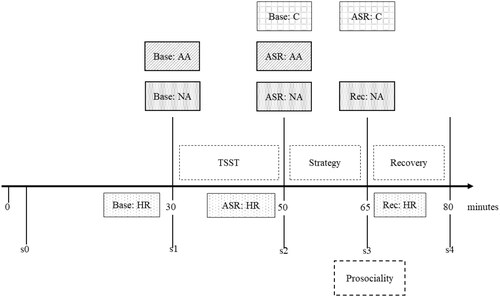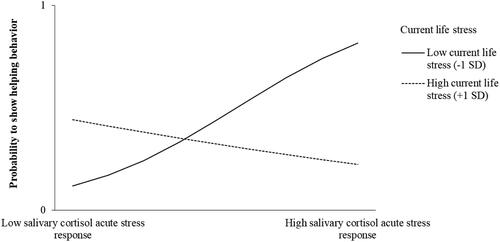Figures & data
Figure 1. Conceptual model. Note. HR: heart rate; NA: negative affect; TNT: think/no-think task. H1: Acute stress responses [(a) HR, (b) NA, (c) alpha-amylase, (d) cortisol] are negatively associated with prosociality [prosocial motivation, helping behavior]. H2: Current life stress moderates the relationship between acute stress responses [(a) HR, (b) NA, (c) alpha-amylase, (d) cortisol] and prosociality [prosocial motivation, helping behavior]. The negative relationship between acute stress responses and prosociality is stronger for individuals with high current life stress. H3: The thought control strategy moderates the effect of acute stress responses [(a) HR, (b) NA] on stress recovery [(a) HR, (b) NA] and prosociality [prosocial motivation, helping behavior] such that individuals with the thought control strategy should be less stressed and more prosocial. H4: Thought control ability and the thought control strategy moderate the effect of acute stress responses [(a) HR, (b) NA] on stress recovery [(a) HR, (b) NA] and prosociality [prosocial motivation, helping behavior] such that individuals with the ability to control thoughts and the thought control strategy should be less stressed and more prosocial.
![Figure 1. Conceptual model. Note. HR: heart rate; NA: negative affect; TNT: think/no-think task. H1: Acute stress responses [(a) HR, (b) NA, (c) alpha-amylase, (d) cortisol] are negatively associated with prosociality [prosocial motivation, helping behavior]. H2: Current life stress moderates the relationship between acute stress responses [(a) HR, (b) NA, (c) alpha-amylase, (d) cortisol] and prosociality [prosocial motivation, helping behavior]. The negative relationship between acute stress responses and prosociality is stronger for individuals with high current life stress. H3: The thought control strategy moderates the effect of acute stress responses [(a) HR, (b) NA] on stress recovery [(a) HR, (b) NA] and prosociality [prosocial motivation, helping behavior] such that individuals with the thought control strategy should be less stressed and more prosocial. H4: Thought control ability and the thought control strategy moderate the effect of acute stress responses [(a) HR, (b) NA] on stress recovery [(a) HR, (b) NA] and prosociality [prosocial motivation, helping behavior] such that individuals with the ability to control thoughts and the thought control strategy should be less stressed and more prosocial.](/cms/asset/fc4f4db3-7457-4acf-91c5-389430478e65/ists_a_2054697_f0001_b.jpg)
Figure 3. Measurement points in Phase 4. Note. Base: baseline; ASR: acute stress response; Rec: later stress response; Strategy: thought control strategy; HR: heart rate; NA: negative affect; AA: alpha amylase; C: cortisol. NA, A, and C were measured at s0, s1, s2, s3, s4. HR was measured continuously.

Table 1. Means standard deviations, and correlations for all study variables.
Table 2. Regression analyses predicting prosocial motivation.
Table 3. Logistic regression analyses predicting helping behavior.
Figure 4. The relationships between cortisol acute stress responses (low level: −1 SD, high level: +1SD) and helping behavior at low to high values of current life stress.

Figure 5. The relationships between negative affective acute stress responses at s2 (low level: −1 SD, high level: +1SD) and negative affective stress recovery at s3 in the EG and CG condition.

Table 4. Regression analyses predicting stress recovery at s3.
Supplemental Material
Download MS Word (51 KB)Data availability statement
The data that support the findings of this study are available from the corresponding author, upon reasonable request.

